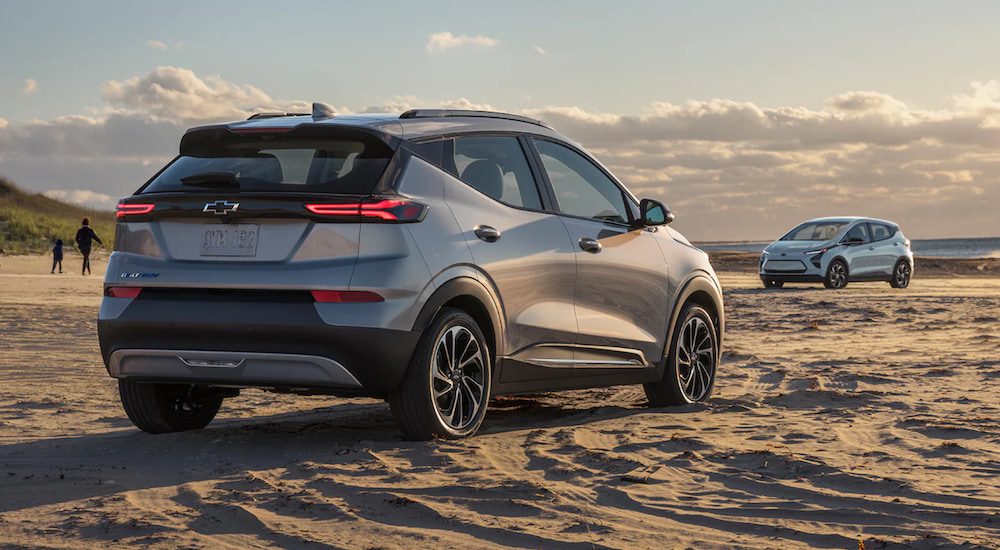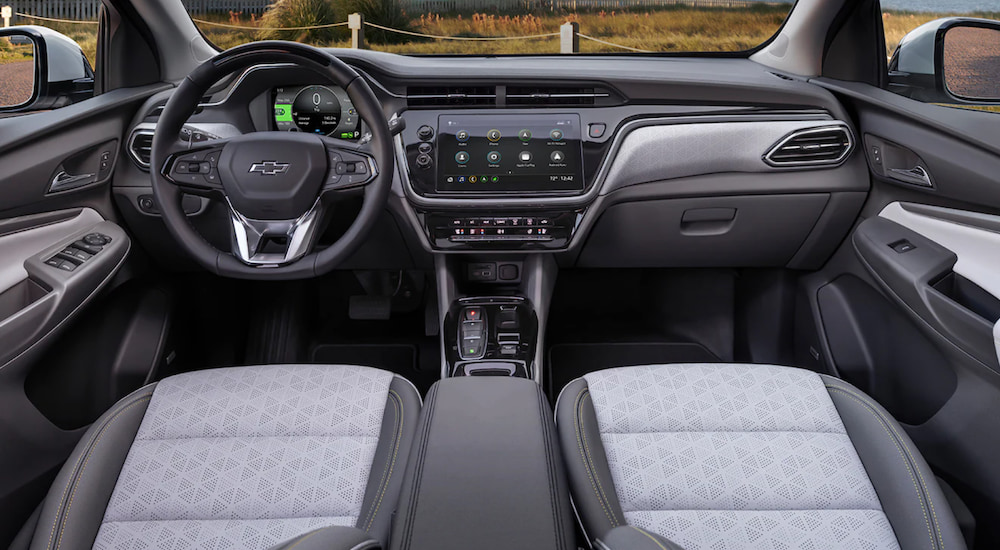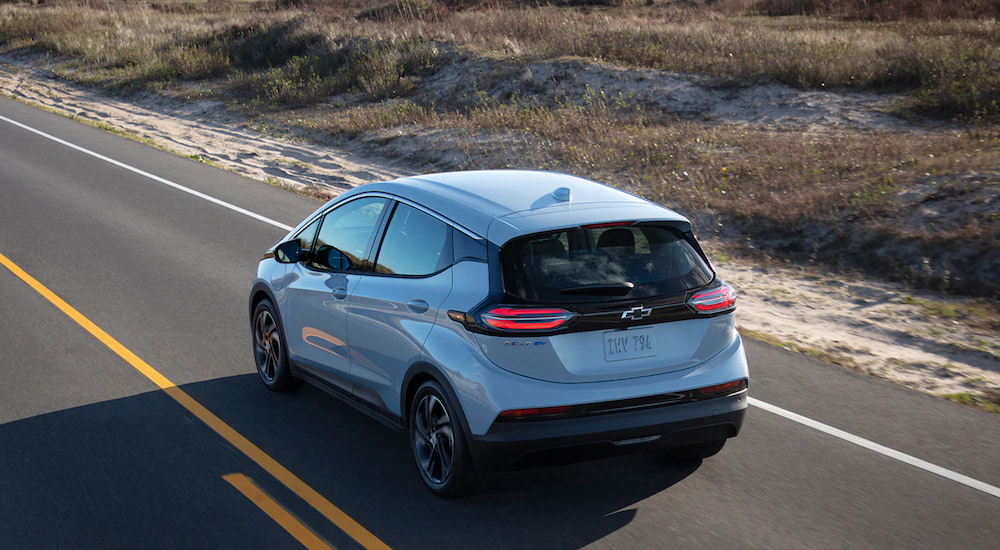When Chevrolet debuted the Volt as a concept car back in January 2007, it raised more than just a few eyebrows. Here was America’s biggest automaker staking its future on a clean, green hybrid vehicle designed to be affordable for the average American household. Unlike other automakers like Tesla that geared its futuristic vehicles for the affluent, Chevy’s goal has been to make alternative energy vehicles for everyday drivers. This goal continues with the next-generation Bolt EV and all-new Bolt EUV, and we can expect more of the same with the recent announcement of an electric Silverado truck. Each of these great new vehicles will continue Chevy’s tradition of making cutting-edge technology affordable for the average driver. I can’t wait to go to a Chevy Dealer Near Me to test-drive each of these new Chevy electric vehicles (EVs) and see how Chevrolet will make cars more efficient with zero emissions without pricing them out of the range of folks like me.
Two Generations of the Chevy Volt Paved the Way
The Chevy Volt made its debut in time for the 2011 model year. Although not a true EV, this Chevy hybrid provided most of the benefits of an EV with its 16-kWh lithium-ion battery. It also provided Chevy with the competitive advantage gained by being an innovator in the field of affordable alternative energy vehicles.
While the Volt had the fairly conventional looks of a four-door sedan, looks can be deceiving. While many of its competitors went for futuristic looks that belong in Mad Max or Blade Runner, Chevy chose instead to puts its money where it matters most: the Volt’s powertrain. Dubbed the “Voltec” propulsion system, it combines a battery-powered electric motor with a conventional internal gas engine serving as a generator to recharge the battery. This combination provides 149 horsepower and 273 pound-feet of torque. It is interesting that EVs tend to be great at generating torque.
The real value in the Volt can be seen in fuel savings, with it able to achieve 93 MPGe in fuel electric mode. These numbers drop to 37 MPG when the gas engine is running, but those are still outstanding numbers, especially for a first-generation hybrid vehicle. While the battery only lasts for 35 miles on a single charge, the addition of the gasoline engine gives the Volt a range of 344 miles.
With the initial success of the Volt, Chevy went ahead with a second generation of the sedan in time for the 2016 model year. This Volt has a more aerodynamic appearance while still avoiding the over-the-top Star Wars styling of many competitors. It also features an improved powertrain, with an 18-kWh lithium-ion battery pack driving a dual-electric motor to the front axle and a 1.5-liter I-4 gas engine to recharge the battery while in motion. This provides 149 horsepower and generates 294 pound-feet of torque in the second-generation Volt.
As a result, the second-generation Volt has an improved range of 420 miles, with 53 miles of all-electric range. With respect to fuel economy, the second generation delivers 106 MPGe when in all-electric mode and a truly impressive 42 MPG in both city driving and on the highway. While Chevrolet decided to discontinue the Volt after the 2019 model year, you can still find many used first and generation models for sale at a great price at your local Chevy dealership.
Bolting Into the Future
Chevrolet leveraged the technical know-how from the development of the Volt to create the Chevy Bolt EV, a true all-electric vehicle with no gas engine to provide assistance. The first Bolt EVs were released to an eager public for the 2017 model year. This vehicle uses a 66-kWh lithium-ion battery to power a permanent magnet motor with 200 horsepower and 266 pound-feet of torque. The EPA-estimated range was 238 miles in early models and later increased to 259 miles. The 2021 Chevy Bolt EV is also incredibly fast, able to take you from 0 to 60 miles per hour in only 6.5 seconds.
Not willing to rest on success, Chevy will be coming out with an updated version of the Bolt EV for the 2022 model year, along with an all-new Bolt EUV. Both of these models are front-wheel drive and run on an improved 65-kWh lithium-ion battery to power their permanent magnet motor, producing 200 horsepower and providing 266 pound-feet of torque. The range of each of these 2022 models is quite exceptional as well. The 2022 Bolt EV has an estimated range of 259 miles on a single charge, while the larger 2022 Bolt EUV has a 250 mile estimated range. This is due in part to each model featuring Regen on Demand to convert kinetic energy into electricity to recharge the battery with the simple pull of a steering wheel-mounted lever.
The 2022 Bolt EV and Bolt EUV will also feature One Pedal Driving. Rather than going from the accelerator to the brake and back, which puts wear and tear on the brakes while increasing driver fatigue, you can simply speed up and slow down by changing the pressure on the accelerator. You can even bring your Bolt EV or Bolt EUV to a complete stop simply by taking your foot off the gas – I mean the accelerator pedal, since there is no gas in these EVs.
The 2022 Chevy Bolt EUV will be the first vehicle offered by Chevy with Super Cruise, a hands-free driver assistance technology that can be used on over 200,000 miles of enabled roads. This system utilizes detailed LiDAR mapping of the Super Cruise highways, while a small camera mounted on the steering column makes sure that the driver remains focused on the road while the Super Cruise system is in action. This feature will be available only on the 2022 Bolt EUV but may be rolled out to other Chevy EVs over time.
Chevrolet has made EVs more affordable for its customers by actually lowering the price on the Bolt lineup. While the 2021 Bolt EV has a base MSRP of $36,500, the 2022 Bolt EV will have an MSRP of just $31,995, and the all-new 2022 Bolt EUV will have an MSRP of $33,995. Chevy’s vice president Steve Hill points out that, “We’ve lowered Bolt EV’s base price by more than $5,000 from the 2021 model, proving our commitment to make EVs attainable to everyone.”
Chevy’s EV Future Is so Bright It Has to Wear Shades
Chevy recently announced that its next EV will be a Silverado electric pickup with an estimated range of 400 miles on a single charge. This truck will combine all the great features of the Silverado pickup truck with technology from Chevy’s Ultium batteries, giving you a truck with amazing capabilities, superior fuel economy, and zero emissions.
Chevrolet has taken its early entry into the EV industry and used it to develop a competitive advantage, creating such great vehicles as the Volt, Bolt EV, Bolt EUV, and now the Silverado electric truck. This commitment to innovation has also paid dividends, allowing Chevy to build EVs that are increasingly affordable for all drivers, passing along the benefits to you and me. With so many exceptional Chevy EVs currently available and even more on the near horizon, it is clear that we will all need to wear shades since Chevy’s EV future will be so blindingly bright.






